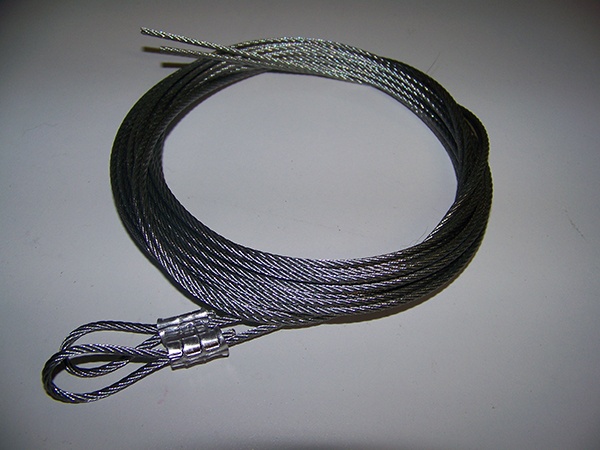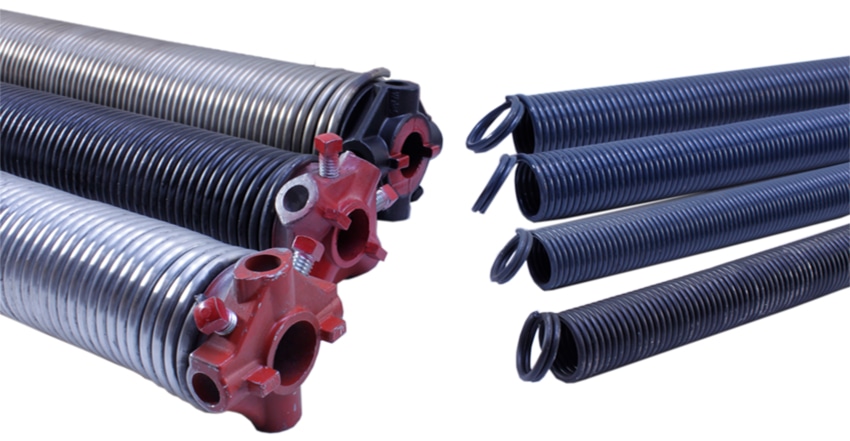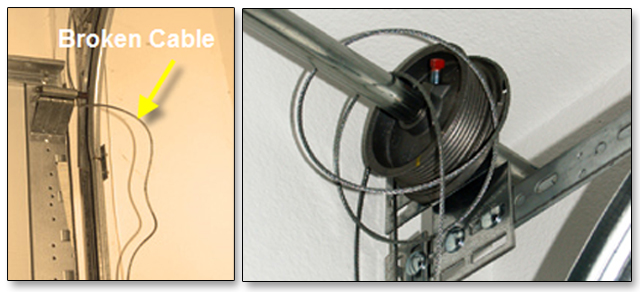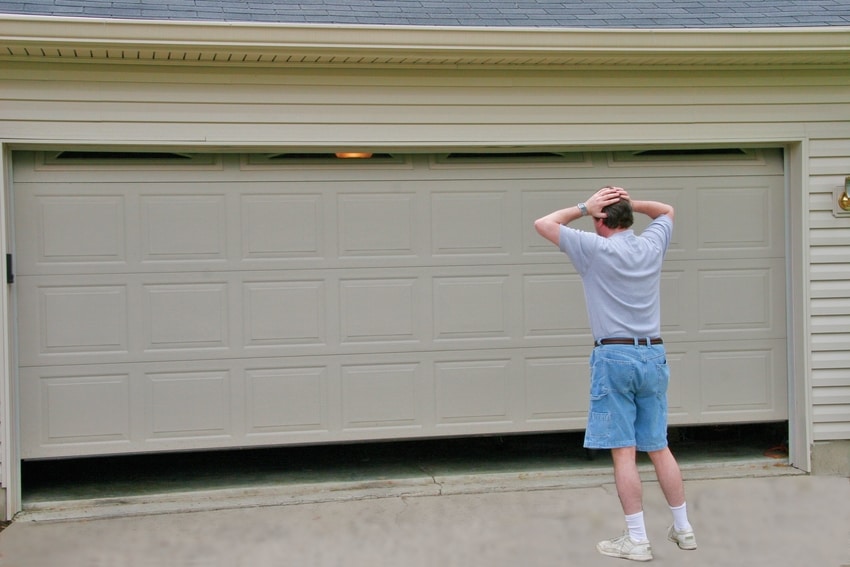Garage Door Cables - Types, Malfunctions & Essential Upkeep

Most homeowners are well acquainted with the core functions and components of their garage door - like the panels that make up the face of the door, the garage door opener, that gets the door moving and regulates its motion, and perhaps even their garage door’s springs. Many people today are even able to control their garage door from halfway around the world through specialized apps on their smartphones. But while homeowners tend to be better informed than ever about their garage doors, there’s still one component of the entire mechanism that can leave them scratching their heads: the cables.
Garage door cables are one of the most underappreciated components of the modern garage door. They’re as old-school as you can get but without them that app that allows you to open your door from the other side of the world would be useless. As would that quiet, reliable motor. That’s because it’s the cables (and the pulleys they’re wound around) that transfer the energy from the springs to the door. No cables and the springs are useless and so is the door.
There are several different cables at work on most contemporary garage doors, and each serves a crucial function. Review our comprehensive guide to garage door cables to learn the different garage door cable types, and the functions served by each, and the top causes of common cable malfunctions.
There are two types of cables on most garage doors: the cables that transfer the energy of the springs to the task of lifting the door and the safety cables that do their best to prevent you from getting hurt in the event of an accident with the springs. Let’s look at the lifting cables first.
The Lifting Cables
Contrary to popular belief the lifting mechanism of your door has little to do with the garage door opener. It’s actually the garage door springs that Broomfield homeowners can thank for the smooth, effortless way the door is lifted up and tucked away into the ceiling of the garage. But the springs themselves are not connected directly to the door. Instead, they’re connected to pulleys or drums over which run cables which transfer the energy of the springs to the task of lifting the door. Typically there is one “lifting” cable on each side of the door. If either of these cables break the door will raise and lower unevenly and will eventually fail altogether.
Types of Lifting Cables
Lifting cables assume one of two configurations because there are two types of springs used to lift the door. They are torsion or extension springs.
- Torsion springs - store their energy by coiling. They sit against the wall above the door itself parallel to it. While lifting the door the torsion spring expends its stored energy. During the process of lowering the door the torsion spring coils back up storing energy for the next lift.
- Extension springs - store their energy by extending. They run perpendicular to the door itself extending back into the garage space parallel to the tracks. Extension springs release their energy when lifting the door and then “recharge” themselves, as it were, as the door lowers and they extend.

With torsion springs the cables are wound around drums at both ends of an axle or spring shaft. As the spring shaft rotates the cables either extend to drop the door or coil around the drum to lift the door. These cables typically last for many years. If they become frayed and snap prematurely however your garage door service in Broomfield will need to figure out what type of obstruction is rubbing against the cable to cause the fraying, and fix it.
Extension springs have a pulley attached to the end over which runs a cable that provides lift for the door. Again, if one of these cables snaps and is not replaced the door will lift unevenly and eventually fail outright.
Why Do Lifting Cables Snap?

The lifting cable is engaged every single time the door is opened and closed. Most wind up coiling onto and off of a drum attached to an axle projecting out from the torsion spring. All the friction from moving up and down, winding and unwinding, while holding aloft hundreds of pounds causes the cable to fray. The steel cable is also exposed to the cold, heat and moisture of the outdoor environment. And this causes corrosion that further weakens the cable over time.
In addition, if the door is even a tiny bit out of alignment this can bring enormous stresses to bear on the cable and can cause it to rub on parts of the door mechanism it should not be in contact with. This only accelerates the process of wear and tear. The sum total of all this stress, corrosion and wear and tear is a broken cable.
How Do I Know If the Lifting Cable Has Snapped?
There are a couple of things you can look for that will indicate that the lifting cable has snapped and needs to be replaced. These include:
- The door is struggling to open - Sometimes the motor will appear to be working fine and the spring or springs also seem to be intact. Yet for some unknown reason the door is struggling to open. If this happens to your door it’s likely either a broken spring or a broken lifting cable and it will need to be repaired ASAP.
- You see what looks like a wire hanging loose - If you notice what looks like a wire hanging loose beside the door it’s likely the remains of the lifting cable that has snapped. These cables can become extremely frayed prior to breaking and the process of snapping frays the individual strands even further.

How to Prevent the Lifting Cable from Breaking
The best way to fend off the untimely and potentially dangerous snapping of the lifting cable is to schedule regular maintenance of your garage door. If the technician notices excessive wear and tear of the cable during one of these visits they can easily replace it with a new one. Even so, you should take a few minutes every month and visually inspect the cables just to make sure they’re not frayed or rubbing up against anything as they move.
The Safety Cables
Safety cables are the cables you hope you never have to thank for saving your bacon. The safety cable extends from the door frame through the extension spring to the other end where it attaches to the hook screw that holds the spring. If the extension spring breaks the safety cable prevents the pieces from whipping around and potentially killing someone or causing grave bodily harm. Keeping the safety cables in good condition is important so that, should the day come when you actually need them, they’re there for you.
In the event that the power goes out and the opener motor is unusable, pulling your garage door’s emergency release cable will disconnect the door from the motor and allow you to open it manually. You’ll find the emergency release cable just inside the garage, hanging from above at the center line of the door.
A Word of Caution
While it may be tempting to replace the lift or safety cable yourself it is in fact a very unwise thing to do. Any project that might bring you in contact with or require you to work on or around garage door springs should always be done by a highly trained, qualified professional. The amount of energy stored in garage door springs is enormous. Many people have died and many more been seriously injured working around them when they have snapped. Don’t become a statistic. Make sure any work done around your garage door springs is always performed by qualified, licensed professionals like our Littleton garage door repair team.
The modern automatic overhead garage door is a complex mechanism that utilizes a combination of old world analog tech and new world high tech. The two types of tech work in concert with each other with the compact, powerful, energy-efficient motor getting the door started and regulating its movement and the old world springs providing the bulk of the raw power needed to lift the door, which can weigh many hundreds of pounds. But none of that raw lifting power would be of much use if it wasn’t for the garage door cables. Below we’ll look at one of the most common problems the garage door repair company faces: slipped cables.
Let’s look at some of the main reasons cables can slip from the drum and necessitate garage door repair in Broomfield, Parker and beyond.
What Prompts Cables to Slip off Their Drums?

Once you hit the “open” button on your garage door remote you set a complex series of events in motion. The motor gets the door going and that causes the springs to release their energy. They transfer this energy to the pulleys which transfers it to the cables which pull on the door, causing it to rise. Sometimes however, cables will slip off their drums or otherwise malfunction. And here are a few reasons why:
- The auto-reverse feature fails - The auto-reverse is a safety feature all modern garage doors share. A beam of light is shined across the opening of the door and if this beam is broken while the door is in motion the door stops. If the auto-reverse isn’t working properly to door may collide with the car which could cause the cables to continue spooling out even though the door has stopped moving. To prevent this make sure you have the auto-reverse feature checked periodically.
- Improperly adjusted springs - Most doors use two springs these days and if one of them is loaded with the wrong amount of tension, either too much or too little, the door will open and close unevenly. This will affect the way the cables interact with the spools. As a result the cable may pop off the spool rendering one side of the door dead weight. If your door is hanging unevenly this may be the reason and you’ll need to call for garage door repair in Loveland.
- Broken spring - Older garage doors used a single torsion spring and many of these doors are still in regular use. If the spring on such a door snaps the drum begins to rotate freely, the cables lose their tension and the door comes crashing down with a bang. More recent doors utilize two springs as we mentioned. So if one of the two springs snap, the door will hang unevenly but it’s not likely to come slamming down on top of your loved ones, your pet or your car.
- Mismatched cables and drums - Oftentimes when unqualified people attempt to fix the garage door they wind up choosing and installing the wrong parts. The wrong size drum will mess up the dynamic of the door and put unreasonable amounts of strain on the cable, which can cause it to fray and snap. There are very precise guidelines for installing the right drums. A professional will know exactly which drum or drums your garage door needs to keep it working at optimal effectiveness.
- Installing the wrong spring - If you’ve recently had a torsion spring snap and had an unqualified person install a replacement, they may well have chosen the wrong spring. Mismatched springs, like mismatched drums, will cause the door to raise and lower unevenly and put a lot of stress and strain on the cables. This can result in the cable slipping off the drum or becoming frayed and breaking under pressure.
- Clogged tracks - If it’s been a long time since you had anyone clean the tracks on your garage door they may have become choked with dirt and debris which will cause the door to open unevenly. This, in turn, can cause the cable to slip off the drum and make things even worse. In addition, resistance caused by dirt-clogged tracks puts a lot of pressure on the motor, causing it to have to work harder than it was designed to. This will, in turn, shorten its life.
Call Us For Garage Door Cable Maintenance and Repairs!

In order to ensure that your lifting and safety cables are always in prime condition, its essential to schedule an annual service check on your door mechanism. This simple step could save you a lot of time, trouble and money in the long run.
If you need help repairing your garage door’s cables - or any other garage door components - call the professionals at A Better Garage Door. We've proudly provided every variety of essential garage door services for nearly 25 years - including garage door cable repair, broken spring repair, garage door installations and more. With decades of Denver-area experience, thousands of satisfied customers, and fully warrantied parts and labor, you can trust our team with everything you need. Call our experienced technicians today!